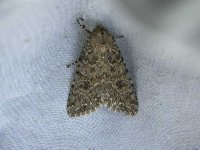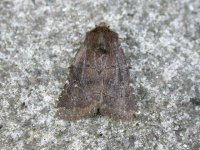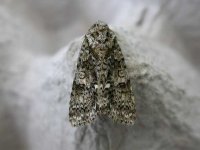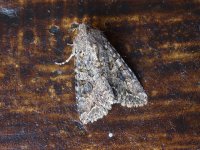-
Welcome to BirdForum, the internet's largest birding community with thousands of members from all over the world. The forums are dedicated to wild birds, birding, binoculars and equipment and all that goes with it.
Please register for an account to take part in the discussions in the forum, post your pictures in the gallery and more.
You are using an out of date browser. It may not display this or other websites correctly.
You should upgrade or use an alternative browser.
You should upgrade or use an alternative browser.
Today's puzzlers (1 Viewer)
- Thread starter Cuckoo-shrike
- Start date
More options
Who Replied?harry eales
Ancient Entomologist
Aquila said:I'm struggling to i.d. these, in the trap this morning. First one: Nutmeg/Dark Brocade/Dusky Brocade or none of these??; second one: Brown Rustic, but where are the feathered antennae?
Andy
Hi Aquila,
It's a bit early for your choices for moth no 1, except the Nutmeg which is double brooded. I think it's more likely to be a specimen of Frosted Green but I haven't seen any as deep a green as that up north. In fact it so scarce up here I haven't seen many at all. The other possibility is Green Arches but if so it's very early. Size is difficult to judge from the picture.
I think your right with Brown Rustic. The feathered antennae are only possessed by males. The females only have the typical thread like antennae which are most likely in the 'rest position' just under the wings.
Harry Eales.
Last edited:
Cuckoo-shrike
Well-known member
Thanks guys. Waring and Townsend shows Frosted Green as having a different rest position. It's also associated with Oak and there isn't any in the vicinity, so I don't think it can be that. Sorry I forgot to mention size. It's about Green Arches size, so I think it must be that. I've had a couple of species this year that are out earlier than is stated.
The size of the other one would be right for Brown Rustic.
The size of the other one would be right for Brown Rustic.
Cuckoo-shrike
Well-known member
No, thinking about it, it was smaller than Green Arches, so I think that is ruled out.
Andy
Andy
harry eales
Ancient Entomologist
Aquila said:No, thinking about it, it was smaller than Green Arches, so I think that is ruled out.
Andy
Hello Andy,
Try having a look at the photographs of Nutmeg and Green Arches on the UKmoths website, that may help you in determining your green moth.
Whilst most moths fit into the size parameters given by various authors be aware that dwarf forms can and do occur in most butterfly and moth species, I have come across a good number of dwarf forms over the years in a large number of insect species. Dwarfism is usually caused by larval starvation by eating gead or dying plant material. Those that survive to pupate result in these dwarf forms which appear in perfect condition, just smaller than usual.
Harry Eales.
Brian Stone
A Stone chatting
It may not be that relevant that you have no oak nearby. If there is any within half a km or so you might still get them. I've had Oak species (e.g. Spring Usher) but there is precious little within 500m of my garden.
Cuckoo-shrike
Well-known member
Thanks all, for your comments. It's certainly causing some problems. One leading authority thinks it's neither Green Arches nor Nutmeg, but he doesn't know what it is!
Cuckoo-shrike
Well-known member
harry eales
Ancient Entomologist
Hello Andy,
You have a Knot Grass there.
Harry Eales.
You have a Knot Grass there.
Harry Eales.
Brian Stone
A Stone chatting
2289 Knot Grass Acronicta rumicis. The white commas where the wings meet are a useful feature.
http://cgi.ukmoths.force9.co.uk/show.php?id=72
Edit: Rats. Beaten to it!
http://cgi.ukmoths.force9.co.uk/show.php?id=72
Edit: Rats. Beaten to it!
Brian Stone
A Stone chatting
Aquila said:Whilst still scratching my head over the last odd moth, here's another which I can't put a name to. It was rather large, approaching, say Green Arches size. In the trap two days ago. Any offers?
Andy
Knotgrass
brianhstone said:Anyone fancy giving this a go? Looks a bit darker overall in reaity. Ta.
I'm a bit behind the times this morning!
But for Brian's moth I first thought of Campion, but on looking at book I wonder if it could be Beautiful Brocade. in others words I don't know!
harry eales
Ancient Entomologist
Hello Brian,
It's a tough one. I won't bet my next beer on it, but have you considered Dusky Brocade, it's a possible candidate even if it's a couple of weeks early. Have you any other pictures of it?
Harry Eales.
It's a tough one. I won't bet my next beer on it, but have you considered Dusky Brocade, it's a possible candidate even if it's a couple of weeks early. Have you any other pictures of it?
Harry Eales.
Brian Stone
A Stone chatting
No different pics yet but it is in the fridge for the day. This pic is not very representative of the overall feel, which is of a much more uniform, darker moth. I had a good close look at it this morning but couldn't come to a firm conclusion. It closely resembles a Pale-shouldered Brocade, but with dark shoulders! The other candidate was Dark Brocade but the reniform stigmata lack the toothed outer edge.
Dusky Brocade is very variable and has dark forms so this could well be a strong contender. The last pic on Jeff Higgott's site is a very similar looking beastie:
http://jeffhiggott.topcities.com/lepidoptera/systematic_list/Noctuidae/2330.html
Dusky Brocade is very variable and has dark forms so this could well be a strong contender. The last pic on Jeff Higgott's site is a very similar looking beastie:
http://jeffhiggott.topcities.com/lepidoptera/systematic_list/Noctuidae/2330.html
brianhstone said:The other candidate was Dark Brocade but the reniform stigmata lack the toothed outer edge.
I'd be confident its not Dark Brocade having seen a couple recently. I'll await further pics though, before I have furhter suggestions on what it may be.
Brian Stone
A Stone chatting
Keep throwing in those flies! However, I don't think it is Grey Arches. It is overall rather dark and the only really significant pale marking is the sub-terminal line with the deep W shape. I'll try for a more representative picture tonight.
Users who are viewing this thread
Total: 2 (members: 0, guests: 2)







